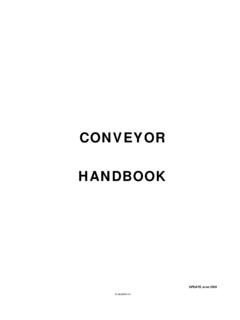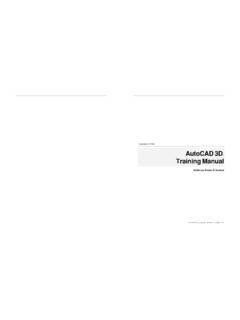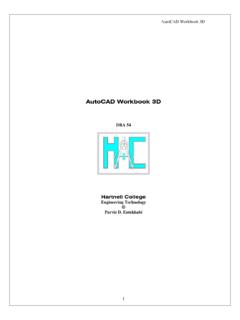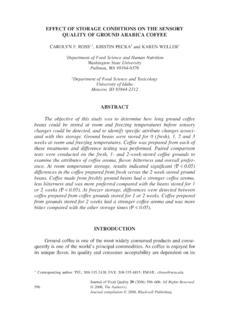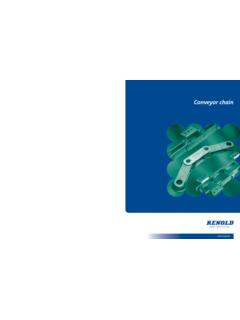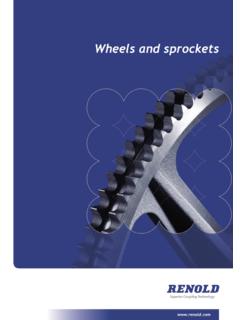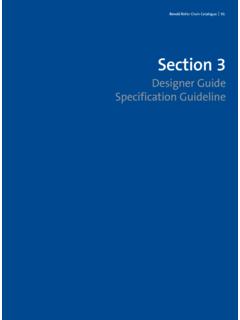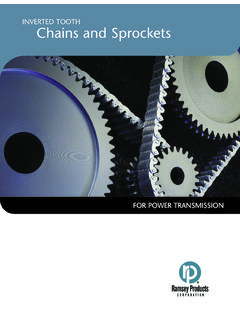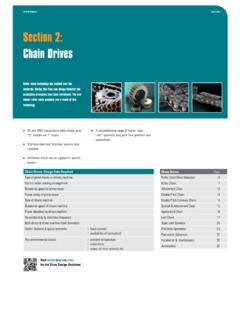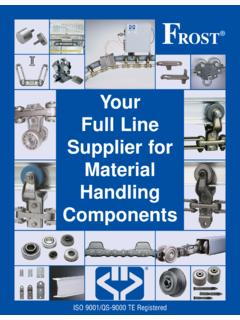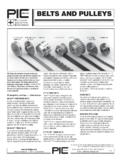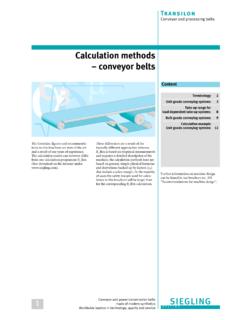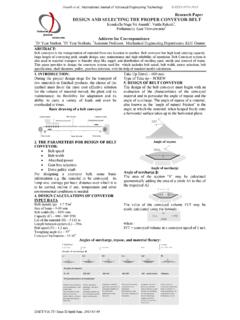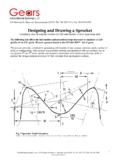Transcription of Pneumatic Conveying Design Guide - Nong Lam University
1 Pneumatic Conveying Design GuideThis page intentionally left blank Pneumatic Conveying Design GuideSecond EditionDavid MillsAMSTERDAM BOSTON HEIDELBERG LONDON NEW YORK OXFORD PARISSAN DIEGO SAN FRANCISCO SINGAPORE SYDNEY TOKYOE lsevier Butterworth-HeinemannLinacre House, Jordan Hill, Oxford OX2 8DP200 Wheeler Road, Burlington, MA 01803 First published 1990 Second edition 2004 David Mills 2004 This publication contains material from PneumaticConveying Design Guide1990 which was written by Dr David Mills under contract with the Department ofTrade and Industry. Crown copyright 1990. Reproducedwith the permission of the Controller of Her Majesty sStationery OfficePermissions may be sought directly from Elsevier sScience and Technology Rights Department in Oxford,UK: phone: 44-0-1865-843830; fax: 44-0-1865-853333; e-mail: You may alsocomplete your request on-line via the Elsevier homepage( ), by selecting CustomerSupport and then Obtaining Permissions All rights reserved.
2 No part of this publication may bereproduced in any material form (including photocopyingor storing in any medium by electronic means and whetheror not transiently or incidentally to some other use of thispublication) without the written permission of the copyright holder except in accordance with the provisionsof the Copyright, Designs and Patents Act 1988 or underthe terms of a licence issued by the Copyright LicensingAgency Ltd, 90 Tottenham Court Road, London, EnglandW1T 4LP. Applications for the copyright holder s writtenpermission to reproduce any part of this publication shouldbe addressed to the publisherBritish Library Cataloguing in Publication DataA catalogue record for this book is available from theBritish LibraryLibrary of Congress Cataloging in Publication DataA catalog record for this book is available from the Libraryof CongressISBN 0 7506 5471 6 Typeset by Charon Tec Pvt Ltd, Chennai, IndiaPrinted and bound in Great Britain For information on all Butterworth-Heinemann publications visit our website at A: Systems and to Pneumatic Conveying and the of of Pneumatic Conveying property feeding devices Part I: Low pressure and lock feeding devices Part II: High and of air compression solid separation selection selection considerations177 Part B.
3 System flow rate flow influence of pipeline influence of influence of use of air mass flow Air only Pipeline pressure Venturi Air flow rate Stepped Nomenclature234 References23511. Conveying Single phase Gas solid The determination of Conveying Energy Component pressure drop Nomenclature257 References25712. Conveying The influence of System capability283 References28613. Material property Conveying Conveying capability Material grade Material degradation effects311 References31814. Pipeline scaling Scaling Conveying Pipeline Pipeline Vertical Pipeline Stepped pipelines349 References35315. Design The use of equations in system The use of test data in system Typical pipeline and material influences37216. Case studies Part I: Fine Conveying Procedure38817. Case studies Part II: Coarse Conveying Procedure39818.
4 First approximation Design Air only pressure drop Universal Conveying characteristics method41319. Multiple use Multiple material Multiple delivery The use of stepped pipelines428 References435 Part C: System Operation20. Troubleshooting and material flow Pipeline blockage43921. Optimizing and up-rating of existing System not capable of Optimizing existing Case Alternative methods of up-rating47422. Operating Types of System System Material related494 References49723. Erosive Influence of Industrial solutions and practical issues512 References524viiiCONTENTS24. Particle Influence of Recommendations and practical Pneumatic Conveying Particle melting544 References54625. Moisture and Air Energy Nomenclature56926. Health and Dust Conveying System Conveying Explosion protection587 References594 Appendix 1: Determination of relevant material size and and bulk properties608 References616 Appendix 2: Additional Conveying and pipelines properties Conveying data622 Index629 CONTENTSixThis page intentionally left blank PrefaceFor this second edition of the Pneumatic Conveying Design Guide I have followed asimilar format to the first edition, in that it is in three parts plus appendices.
5 There thesimilarity ends, however, for the material within these parts has been completely updated,substantially extended and re-developed to make it more accessible. The figures andillustrations are incorporated into the text for easy reference and the work is presentedin a single first part of the Design Guideis devoted to Systems and Components and generalinformation on Pneumatic Conveying . This provides an understanding of dilute and densephase Conveying modes, solids loading ratio and the influence of pressure and convey-ing distance, and hence pressure gradient, on flow mechanisms and capabilities. It alsoprovides a review of major system types, feeding devices, air movers and filtrationdevices. A multitude of decisions have to be made with regard to the selection of aconveying system for a given duty and these chapters will be invaluable in this new book brings all this information right up to date. Feeding devices are coveredin two chapters and are divided between high and low pressure (including vacuum)systems, following developments in this area with regard to blow tanks, rotary valvesand the application of lock hoppers.
6 A completely new chapter has been included onpipelines and valves, which is probably unique, and reinforces the very practicalapproach of the second part of the Design Guideis devoted entirely to System Design and is anentirely new and updated presentation. In this second edition I have incorporated the mainfeatures of the Abbreviated Design Guide in two case studies. These help to reinforcethe application of the scaling parameters and Design procedures that are emphasis is placed on material types and Conveying capability, since this is where there have been major advancements in the understanding of the grades of exactly the same material can give totally different Conveying resultsand so this aspect of Conveying performance is highlighted. Entire chapters are devotedto topics such as First Approximation Design Methods and Multiple Use Systems. Forfeasibility studies, a quick solution is often required so that system economics can beassessed and particularly operating costs.
7 There is often a need for a single system toconvey a number of different materials, and possibly to a number of different loca-tions, and these Design issues are third part of the Design Guideis devoted to System Operation and covers amultitude of very practical operational issues, such as damage to the plant when con-veying abrasive materials, and damage to the conveyed material by the conveyingplant when handling friable materials. I have re-written the first edition chapters andhave included additional chapters on Moisture and Condensation, and Health and part of the book will be invaluable to any engineer who has to commission a pneu-matic Conveying system or is responsible for the maintenance and operation of suchsystems. Pneumatic Conveying systems have a reputation for their operational diffi-culties and so problems of pipeline blockages and systems not capable of meeting therequired duty are considered in detail. The twin problems of erosive wear and particledegradation are also considered in depth, with numerous means presented on howthese problems can be minimized, if not have included two Appendices: one is concerned with the determination of mate-rial properties; and the other contains additional data not incorporated in the text.
8 Aparticular feature of the Design Guideis that it provides an understanding of the rela-tionship between the Conveying capability of a given bulk particulate material andmeasurable properties of the material. A correlation is included that will give a rea-sonably reliable indication of whether a material is capable of being conveyed in densephase and hence at low velocity. A vast amount of practical data, in the form of con-veying characteristics, is included and throughout the book this data has been used toillustrate the derivation of scaling parameters and performance capabilities. This data,and that included in the second appendix, can be used for Design main Design and operating parameter required by engineers working with pneu-matic Conveying systems is the value of the minimum Conveying air velocity for amaterial. I have provide this information for all materials included in the Design Guideand have given guidelines for its assessment for any that are not.
9 Pipeline bends,stepped pipelines, Conveying through flexible hoses, and Conveying both vertically upand down are all issues that tend to cause problems. These pipeline features influenceall aspects of Pneumatic Conveying and are addressed at appropriate points throughoutthe Design have been working in the field of Pneumatic Conveying for thirty years. In this timeI have written over 170 technical papers for journals and conferences, I have supervisednumerous PhD programmes and have presented many short courses to industry. Myown PhD was on the erosive wear of bends in Pneumatic Conveying system pipelines. Iwas then commissioned by the Department of Trade and Industry to write the originalPneumatic Conveying Design Guide . In 1988 I was appointed Professor of Bulk SolidsHandling at Glasgow Caledonian University and since 1996 I have worked as an inde-pendent consultant in Pneumatic David MillsCanterburyJuly 2003xiiPREFACEPart ASystems and ComponentsThis page intentionally left blank IntroductionThe Pneumatic Conveying Design Guide is intended to be of use to both designers andusers of Pneumatic Conveying systems.
10 It has been written on the basis that the readerknows little or nothing about Pneumatic Conveying or Pneumatic conveyors, henceeach aspect of the subject is discussed from basic principles and many of the chaptersare of an introductory nature. The Guide , however, also includes detailed data and infor-mation on the Conveying characteristics of a number of materials embracing a wide rangeof data can be used to Design Pneumatic Conveying systems for the particular mater-ials, using logic diagrams for Design procedures, and scaling parameters for the con-veying line configuration. Where Pneumatic conveyors already exist, the improvement oftheir performance is considered, based on strategies for optimizing and up-rating, andthe extending of systems or adapting them for a change of material is also this introductory chapter a brief introduction to Pneumatic Conveying is given tointroduce the common terms and concepts. First among these are dilute and dense phaseconveying and the specific problem of compressibility of air and other gases that mightbe used.
